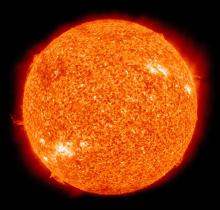Listen to today's episode of StarDate on the web the same day it airs in high-quality streaming audio without any extra ads or announcements. Choose a $8 one-month pass, or listen every day for a year for just $30.
You are here
Dark Matter
The Coma Cluster consists of more than a thousand galaxies, all moving through space together. Yet most of the cluster is invisible — it consists of dark matter. It produces no energy, but its gravity pulls on the visible matter around it.
The Coma Cluster provided the earliest evidence of dark matter. It was first suspected by Fritz Zwicky, who was born 125 years ago this week. We’ll have more about him tomorrow.
Zwicky was studying observations of the Coma Cluster made by Edwin Hubble, the namesake of Hubble Space Telescope. He found that many of the galaxies were moving too fast to be held by the gravity of the cluster’s visible matter. He surmised that some form of “dark matter” was contributing to the cluster’s total gravity.
But there were so many uncertainties in the observations that other astronomers didn’t buy it. It wasn’t until the 1970s that enough evidence began to pile up to convince most astronomers.
Today, we know that dark matter makes up about 85 percent of all the matter in the universe. Yet we still don’t know what it is. The leading idea has been that it’s a heavy subatomic particle. But searches have all come up empty. So new searches are focusing on much lighter particles — perhaps the “missing mass” of the universe.
The Coma Cluster is in the constellation Coma Berenices, which climbs into good view in the northeast by 10 or 11 p.m. Small telescopes reveal several of the cluster’s galaxies.
Script by Damond Benningfield






